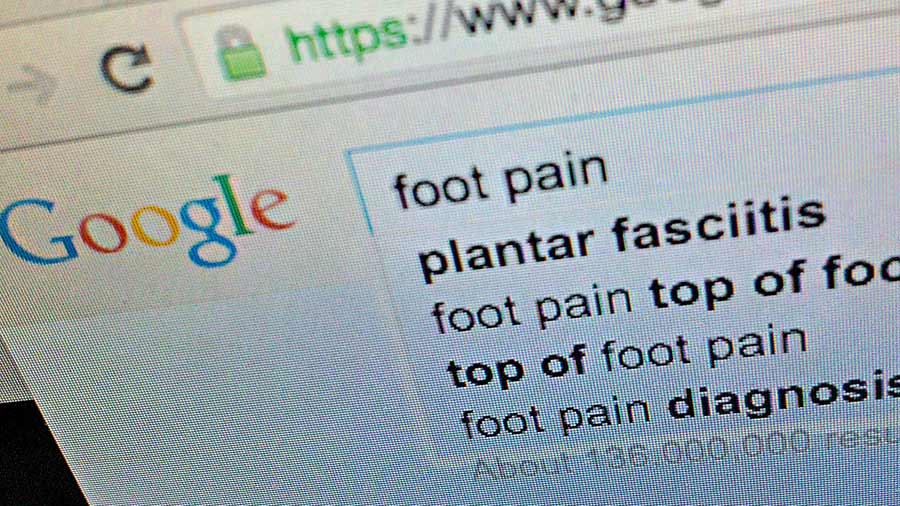
Researchers looked at Google trends for searches on foot and ankle pain. Creative Commons Attribution-NonCommercial-ShareAlike 4.0 International License.
If you found this article by searching online for foot or ankle pains, you’re not alone, especially during the summer.
New research has uncovered how patients are using Google to explain injuries and find possible treatments, with summer searches more than a third higher than those in winter.
Experts from the Institute of Applied Health Research at Glasgow Caledonian University in the United Kingdom studied Google Trends data about health questions asked online.1
They said the results raised issues for health care providers about getting accurate and useful information to the public before they ever seek an appointment or formal treatment.
Report co-author Dr Scott Telfer,2 research fellow at the institute, told Tomorrow that while internet searches during flu season have been examined before, they wanted to see what patterns would emerge on foot and ankle pains.
He said: “The modern thing is before you go to your doctor, before you contact the physio, you go on to Google to see what kind of information you can find by yourself. Nobody wants to go into the doctor’s surgeries these days without some background knowledge I think.
“It seems like it is a misconception but people do believe that in the winter months, so when it’s cold and damp, things like arthritis symptoms and things like that are worse. However, when people have looked at this in more detail, there doesn’t seem to be any strong evidence that that kind of seasonality exists. So to an extent, our results back up the fact that there isn’t really much to that idea.
“We were really surprised how strong the signal was, showing that there was a big increase for the number of searches carried out for foot and ankle pain in summer months compared to the winter months.
“It is a world-wide phenomenon.”
The researchers looked at a decade of data, from 2004 to 2014, from the United Kingdom, United States, Canada and Australia for the relative trends, not a specific number of searches. They looked at terms such as “foot pain”, “ankle pain” and “heel pain”. Possible treatment options included “foot orthotics”, “insoles” and “foot surgery”.
In the northern hemisphere, searches for “foot pain” were 35 per cent higher in summer than winter, with a 31 per cent jump for “ankle pain”. “Heel pain” was even higher with a 58 per cent seasonal rise. Australian data did not go back as many years but there was still a rise in searches in Australia during their summer months of 21 per cent.
Searches for possible solutions to foot and ankle pain were also higher in the summer but by a smaller difference.
The paper it concludes health professionals need to be “aware of the strong interest in medical information relating to foot and ankle pain on the internet”.
It added: “It should also be noted that the quality of the information relating to medical problems that is available online is highly variable.”
The researchers said there was more work to do on what Google searches might indicate about health questions amongst the public and how it compares to actual GP or clinical data. There is no way to tell from the trend data if individuals are searching multiple times for information on the same ailment or whether they then speak to a health professional.
The paper also states that the age difference in use of the internet – 56 per cent of those aged over 65 compared to 97 per cent for those aged 18 to 27 – could skew the results. Further study would be needed.
Although younger, more active people might be searching for health answers in the summer after injuries, Dr Telfer said the internet penetration levels for older ages suggests their results would stand up across the board.
He added: “What we’re interested in taking this forward, can we use this information to inform how health care is provided? Will we get more ankle sprains in the summer months? Can this make them more efficient so they’re set up to receive more ankle sprains during that time period and during the winter months they can be more focused on other problems?”
Information overload?
A study published by the BMJ in July looking at 23 online symptom checkers found them to have flaws in diagnosis and treatment, and that “triage advice is generally risk averse”.3
But with 15 million visits a month to NHS Choices in the UK and a third of American adults regularly self-diagnosing, is online information doing more harm than good once patients turn up at doctors’ offices or hospitals?

Other search engines are available. Creative Commons Attribution-NonCommercial-ShareAlike 4.0 International License.
Dr Urmimala Sarkar is an associate professor of medicine at the University of California, San Francisco (UCSF) and practices medicine at San Francisco General Hospital’s Richard H. Fine People’s Clinic, helping those without health insurance who are elderly or on very low incomes.4
She has previously studied online reviews of doctors and how they correspond to care relationships in person. Dr Sarkar said the availability of information online can be positive and help patients manage their own care.
“Sometimes people think that physicians have this very negative reaction to people doing internet searching,” she told Tomorrow by phone. “It’s really always a challenge for the physician to encourage people to engage in their health. And that’s a perfectly reasonable way of engaging in your health, actually.
“I always say to patients, ‘I’m really happy that you’re prioritising your health and that you took the time to look it up and let’s look together at the information you have and I’ll tell you what I think about it’.
“I have a lot of people who come in and they’ve learned some sensible things online and they’ve done some good self-care things and they’re able to tell me, ‘I tried these three things, they didn’t work, so I’m coming to you’.
“And then there are times when they come in and they just have not attributed their symptoms to the correct issue and because I know them and I’ve been taking care of them for a while, I have a better idea than what you would guess from hearing their symptoms than reading online. It varies a lot.”
Having more information online, and being able to access more about a particular condition or treatment, is almost always a good thing. But sometimes for chronic conditions, the key is finding the right amount of detail so it’s not overwhelming.
And for public health information, organisations need to use web tools and tricks to ensure Google shows what is relevant and accurate.
Dr Sarkar said: “I tell my patients to look at things that are actually produced by health professional societies – there are a number of physical therapy associations in the United States that have wonderful exercises on their websites. And I ask people to look at the education that comes from the American Cancer Society or the America Heart Association or the American Diabetes Associations because those are organisations that I know or trust.
“And that’s really the only way that I can feel comfortable. I wouldn’t send them to another random website that I hadn’t vetted well.
“What we, as health professionals, can do is partner with our patients and try to together sort out what is most useful and relevant and helpful for patients in the context of their own life, which they know best about, and my medical perspective.”
Tomorrow reached out to national health departments in the UK, Australia and the US but did not receive replies.
Sylwia Krzyszton, spokeswoman for Health Canada and the Public Health Agency of Canada,5 said in an email statement that the department uses internet technology and social media to get information to the public.
She wrote: “Health Canada uses multiple methods to promote health information to Canadians on the internet, including social media channels to highlight relevant health and safety topics and to encourage Canadians to read more on the Canada.ca website.
“The department uses internet advertising such as web banner ads, search engine marketing and social media advertising to maximise the reach of this health information.
“The department also uses effective web writing techniques and plain language (that incorporates keywords) which helps ensure that Canadians find the Government of Canada’s credible health and safety information when they are searching the internet.”
Do you trust what you find online? What factors do you use to decide what health answers are trustworthy?
- “Let me Google that for you: a time series analysis of seasonality in internet search trends for terms related to foot and ankle pain” was published in July in the Journal of Foot and Ankle Research. ↩
- Dr Telfer GCU profile page. ↩
- ”Evaluation of symptom checkers for self diagnosis and triage: audit study” – BMJ 2015; 351 doi: http://dx.doi.org/10.1136/bmj.h3480 (Published 08 July 2015) ↩
- UCSF profile page. ↩
- Health Canada website. ↩

